#niolamia argentina
Explore tagged Tumblr posts
Text
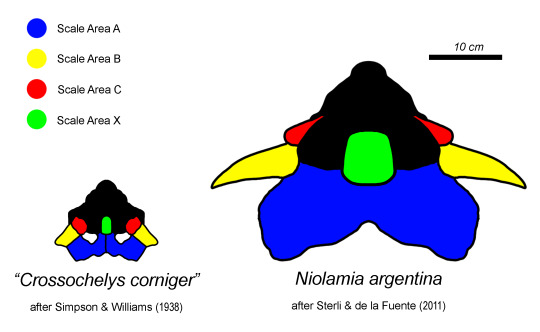

Niolamia is a fascinating turtle. Living during the Eocene (probably), it is one of the earliest known meiolaniids. What makes meiolaniids special is not just that they were sizable land turtles, but two other things 1) The massive horn-like scales, primarily those marked A-C. Niolamia has some of the most impressive ones at that, with the A scale forming an almost ceratopsian-like frill at the back of the head and two large, flattened, side-ways directed horns before said frill. 2) The long tail was armored, covered in bony rings with spikes and in some species even a straight up tail club
The two images above are things I put together for the Wikipedia page of Niolamia. The first shows the growth of the species. The small skull is a juvenile Niolamia, originally described as Crossochelys but synonymized by later researchers. The bigger skull (to scale) is the neotype (or holotype?) of Niolamia. Check out an older post for some history on that. The other is a simple sideview of the skull and lower jaw, nothing too fancy.
The bottom two photos aren't mine but those of Victoria Arbour, but show the weirdness and size nicely. The first image shows Niolamia (right) next to Ninjemys (left). While the second picture shows Ninjemys with as I said Victoria Arbour. Which still gives a good idea of how big these animals heads were.
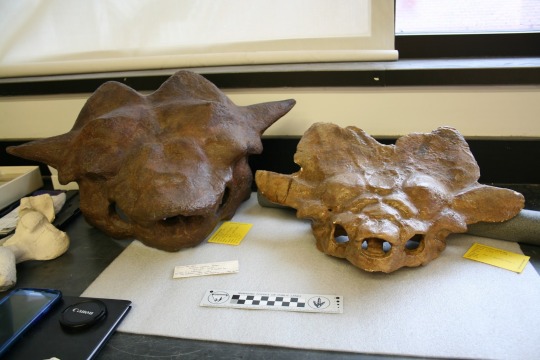
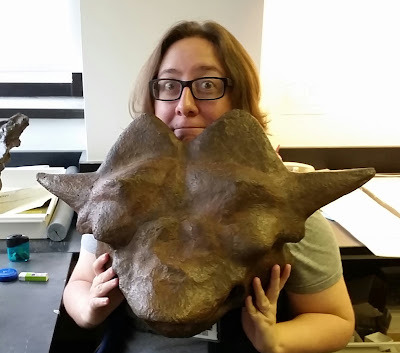
#niolamia#niolamia argentina#paleontology#palaeblr#meiolaniidae#ninjemys#prehistory#turtle#tortoise#extinct#prehistoric
131 notes
·
View notes
Photo

HORA DORADA (2/2) 🐢 Lo único que podría hacer aún más extrañas a las tortugas sería que tuvieran cuernos, ¿no? 👀 Pues bien, durante el Cenozoico existió en el hemisferio sur una familia de tortugas, las Meiolaniidae, caracterizadas por su gran tamaño, sus colas largas acorazadas... y sí, también por sus ornamentados cráneos con cuernos. La relación de parentezco entre los meiolánidos y el resto de las tortugas no está aún del todo claro, pero la hipótesis más fuerte sugiere que no pertenecen a ningún grupo de tortugas actuales, sino que son un grupo hermano de éstas. Los meiolánidos fueron un grupo bastante exitoso de tortugas, habiendo sobrevivido incluso tal vez hasta el Holoceno, siendo probable que hayan tenido encuentros con los primeros seres humanos (e incluso quizá hayan sido éstos últimos los causantes de su extinción). Entre 37 y 48 millones de años atrás, durante el Eoceno medio, un individuo juvenil del meiolánido Niolamia argentina tomaba el sol al atardecer luego de refrescarse a orillas de un lago patagónico, en un bosque de lo que hoy es el sur de la provincia de Chubut, Argentina. ¿Conocías a los meiolánidos? ¿Sobre qué otro grupo de animales te gustaría verme dibujar a sus representantes más extraños? ¡Saludos, y #SeanCreativos! 💭💡✏ 🌐https://smart.bio/martintalone #illustration #drawing #art #traditionalart #colorpencils #ink #watercolour #animal #animals #animalart #wildlife #paleontology #paleoart #fossil #fossils #fossilfriday #turtle #turtles #tortoise #tmnt #hardshell #armor #armored #scale #scales #reptile #reptiles #horns #horned (en Chubut Patagonia Argentina) https://www.instagram.com/p/Cd4B76CvMhx/?igshid=NGJjMDIxMWI=
#seancreativos#illustration#drawing#art#traditionalart#colorpencils#ink#watercolour#animal#animals#animalart#wildlife#paleontology#paleoart#fossil#fossils#fossilfriday#turtle#turtles#tortoise#tmnt#hardshell#armor#armored#scale#scales#reptile#reptiles#horns#horned
1 note
·
View note
Text
Meiolaniidae
So honestly I'm relatively new to digital painting. I sketched a little here and there, made skeletals, but actual painting I've done very little. But I ended up putting this together for my work on the Wikipedia page for meiolaniid turtles. (Yes the Ninjemys colours are a reference to it being named after the TMNT)
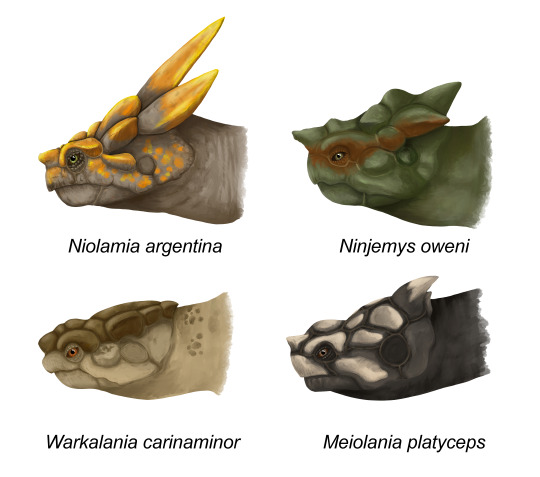
I've rambled a bit about them before, but basically, meiolaniids are weird stem-turtles thought to be outside the two main modern groups we have. They were decently large animals, their shells alone range from 1 meter to 2 meters in length (3 to 6ft I believe?), they were land animals, had some crazy horns and tails that were encased in spiky armored rings and tipped with a tail club. Here some photos with paleontologist Victoria Arbour, a Ninjemys tail club photographed by Serjoscha Evers and a Meiolania tail club illustrated by W.H. Wesley.


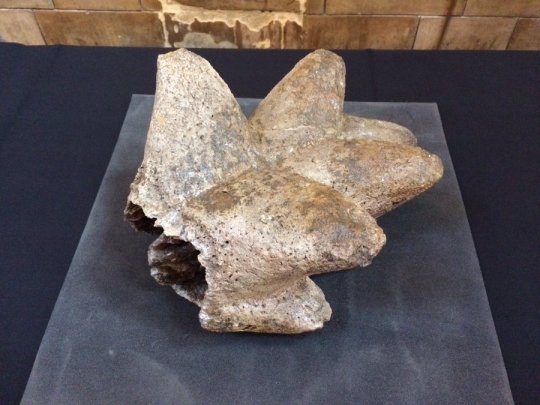
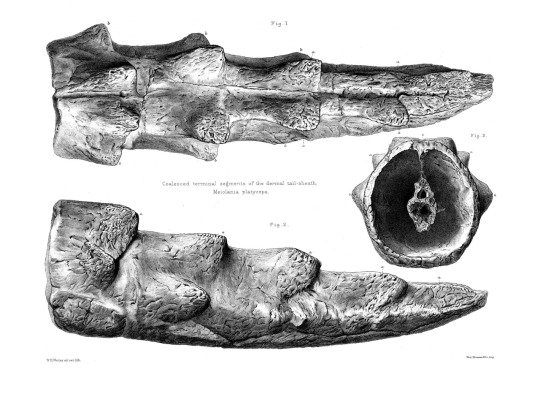
They were found throughout almost the whole Cenozoic, with the oldest form dating to the Eocene of South America and the most recent ones living from the Pleistocene to Holocene in Australia and on various South Pacific Islands. They are honestly pretty cool animals and super underrated, which is why I decided to give their wikipedia pages upgrades in the first place. Which also meant doing a bunch of other illustrations (that I was more in tune with) and pulling a bunch of public domain photos and putting them on wikimedia. Here some skeletals and charts I made, open the last pic, it shows multiple different Meiolania species atop each other.
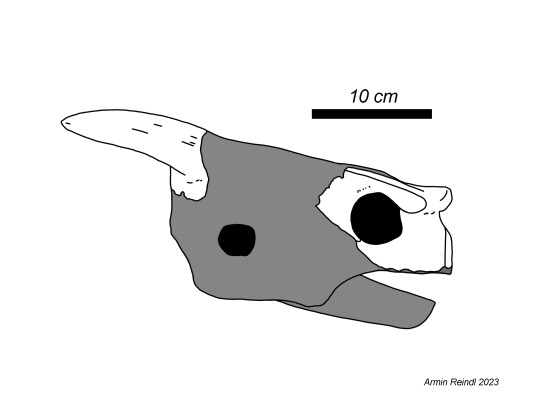

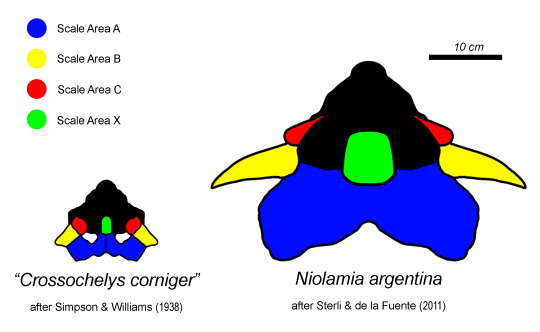
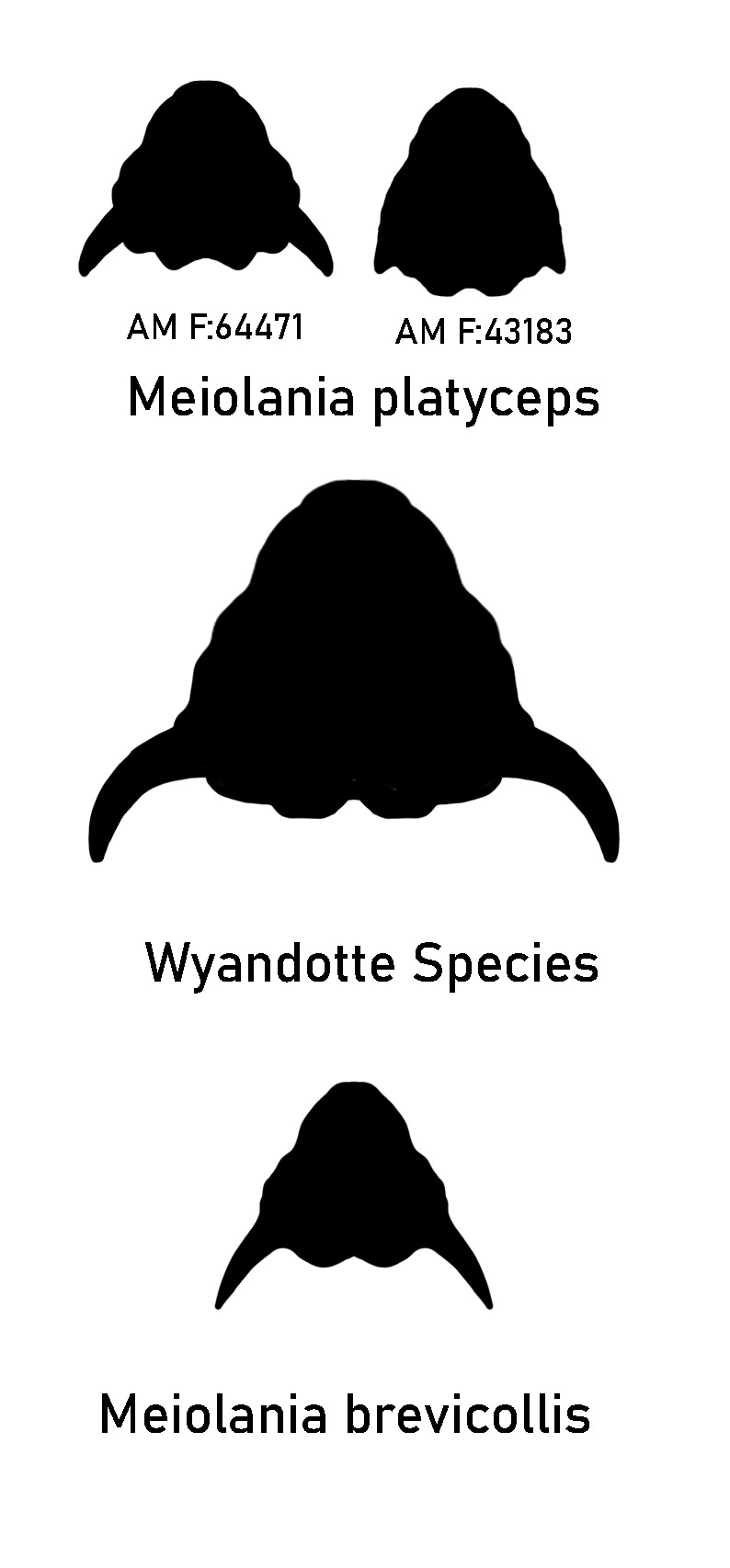
The results were pretty mixed tbh. Some of the most recent forms, Gaffneylania, Warkalania and even Ninjemys had relatively little to write about. But things were more exciting with Niolamia (if you remember my rant about its messed up history). Meiolaniidae itself was just a big summary of all the other stuff, but easily the most extensive was Meiolania itself, which took AGES to research and put togehter. Tho I'm pretty happy with the result. Here's a little side by side, old and new.
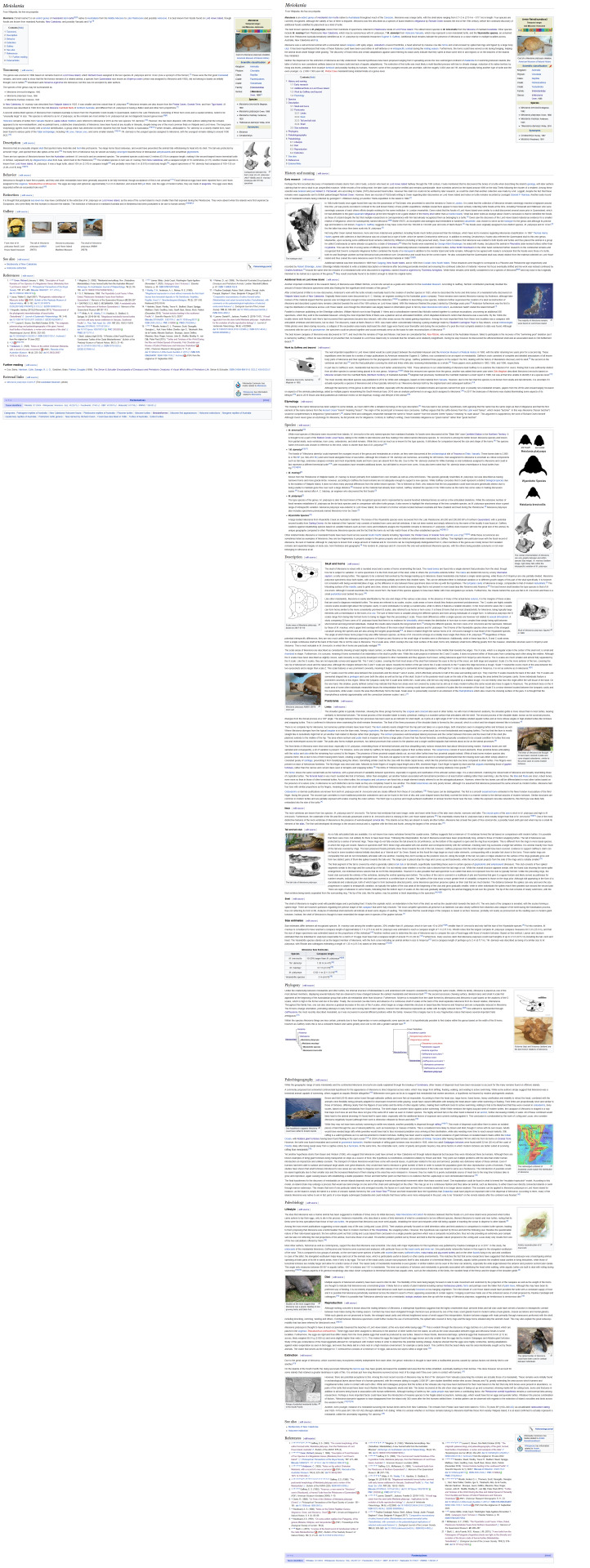
#turtles#wikipedia editing#meiolaniidae#meiolania#niolamia#gaffneylania#ninjemys#teenate mutant ninja turtles#warkalania#tortoise#palaeblr#paleontology#prehistory#australia#argentina#cenozoic#long post#paleo art#skeletal
211 notes
·
View notes
Text
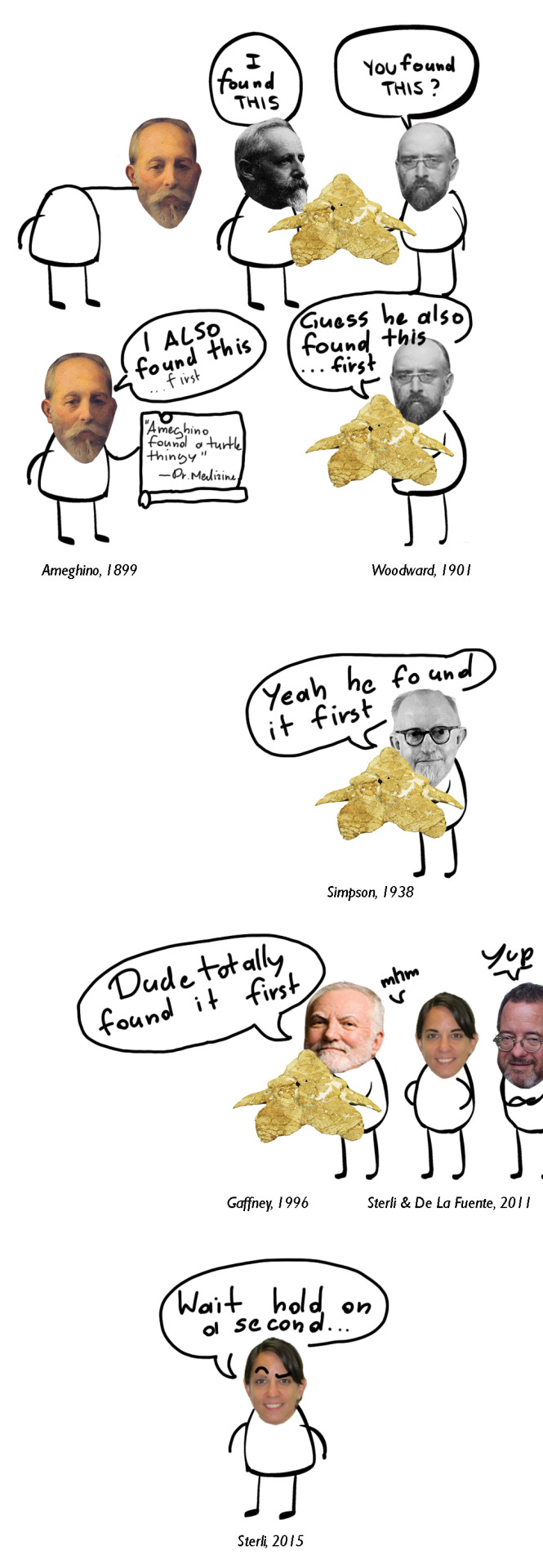

"Paleontology can be really petty and stupid"
In 1898 Santiago Roth discovered the armored tail of a large turtle in Patagonia, which he showed to British paleontologist A.S. Woodward. Recognizing it as the remains of a meiolaniid, Roth was told to go on an expedition to find more material, which he did. This material, which included an almost fully preserved skull, was initially published on in a brief communication in 1899.
Strangely, also in 1899, Florentino Ameghino published his own communication claiming that his brother Carlos had found the almost fully preserved skull of that same kind of turtle, a meiolaniid he dubbed Niolamia argentina.
It is curious how both Ameghino and Roth seem to have found the exact same material of a meiolaniid in different localities at the same time, but weirder things have happened. Tho it is further pretty weird how Ameghino rushed to get a name out, but didn't bother describing what defined the animal nor designated a holotype. Hell he didn't even illustrate his skull. But lets give him some time.
Two years pass, its 1901 now. Woodward publishes a proper description of Roth's skull, illustrating the animal in detail. Having heard that Ameghino found a remarkably similar fossil, Woodward assigns the Roth skull to the same species as the Ameghino skull. Although he doesn't carry over the genus Niolamia, instead placing the fossils in Miolania (a misspelling of Meiolania, described a few years prior from Australia). Ameghino didn't seem to mind or disagree, tho he still hadn't properly described nor figured his skull.
1938: Ameghino is dead at this point and weirdly, his Niolamia skull is still nowhere to be found. Since his initial description was wholy insufficient, George Gaylord Simpson (yes thats his actual name) decides to declare the Roth skull the type specimen for Niolamia (the neoptype). Meaning that the genus is now defined on this skull rather than the one Ameghino had when coining the name.
Fast forward to 2011. It is now generally accepted that Roth's skull is the fossil that defines what Niolamia is. Of course Ameghino still gets credit, after all he described the first remains, even tho nobody has ever seen those...ever really. Over a 100 years passed and far as anyone could tell, the last person to have seen those bones were Ameghino and his brother, after which they just disappeared. But we still got the Roth skull, and Juliana Sterli and Marcelo de la Fuente could readily redescribe Niolamia based on that.
But Sterli seems to suspect that something very fishy is going on. Remember, Ameghino just happened to find a perfectly preserved skull at the same time as Roth did. Ameghino made sure to get a name out before Woodward got around to fully describe it. Ameghino only vaguely compared the skull to Meiolania, but didn't specify its unique features nor did he actually illustrate his material. So Sterli said out loud what I'm sure many people must have been thinking. "Did Ameghino just make it all up?"
In 2015 Sterli comments on the matter by noting how awfully convenient the whole situation was. Although no concrete evidence exists, Sterli suggests that Ameghino may have found out about Roth's skull, lied about having found a similar one, and named Niolamia not on a fossil he actually had but based on what little he knew about Roth's discovery.
This is just a basic summary of a rabbit hole I recently went into and my god its so frustrating on so many levels. Again we don't have concrete evidence that Ameghino's skull didn't actually exist, but the way the timing lined up and the fact that he was in a feude with Francisco Moreno, which has been likened to an Argentinian Bone War, means that this suggestion isn't that out there. It really doesn't help that his supposed skull was only ever mentioned by him in 1899 and never again. Ameghino never claimed it was destroyed or stolen, hell, far as I could find he even agreed with Woodwards research.
What's also fascinating is that seemingly, for over a hundred years, nothing was written in scientific literature casting doubt over his claim. I'm sure some people must have called bullshit on him in private, but the only resource I could find that actually goes as far as to say "Hey isn't his weird that the Ameghino skull is basically a phantom" came out in 2015. Everything in-between seemed content with just assuming that Ameghino and Roth both had skulls and just never followed up on whatever happened to the former. Then again I could just as much understand if people just didn't want to deal with this nightmare of a backstory.
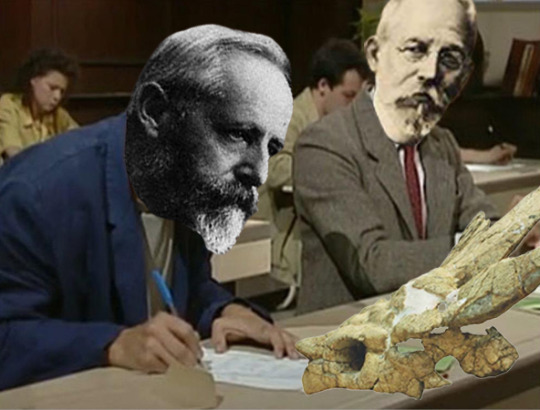
#paleontology#ameghino#florentino ameghino#niolamia#history#prehistory#palaeblr#coproliteposting#meiolaniidae#turtle#paleontology history
263 notes
·
View notes